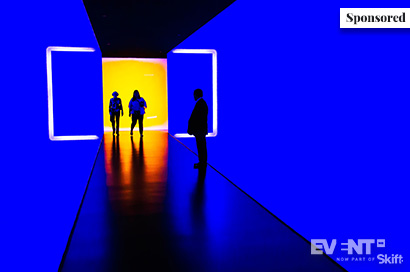Skift Take
If you want to join the ranks of event planners evolving into event strategists, you’ll need to understand all the trends and best practices defining the future of the industry.
We’re still in the first quarter of 2020, and there’s no shortage of buzz around what event trends will dominate the coming year.
The biggest drivers are only gaining momentum: sustainability, experience design, AI-powered tech, and human-centric event planning.
Of course, it’s one thing to hear about these trends and another to put them into practice. If you want to be part of the larger evolution of event planners into event strategists, you’ll need to know how to implement them effectively to stay ahead of the game.
To give you practical guidance on what the latest trends mean in concrete terms, we sat down with two industry leaders from Las Vegas landmark The Venetian Resort: Chandra Allison, Senior Vice President of Sales, and Olivier Dubreuil, Vice President of Culinary Operations and Executive Chef.
From structural efficiencies to F&B management, here are 9 ways to turn top trends into tangible results.
This video was produced by EventMB and Skift via the SkiftX Creative Studio in partnership with The Venetian Resort Las Vegas.
Trend 1: Sustainability
Perhaps the most significant trend is sustainability. Sustainability is not just a nice-to-have — it’s actually a necessary response to an emergency situation.
With the trade show industry being the second-largest contributor of waste after the construction industry, this is a commitment on the part of all responsible event professionals to secure the tenable future of the industry.
Partner with Venues and Communities to Combine Sustainability and CSR Initiatives
“We’ve reached a tipping point where sustainability is no longer an option,” Allison says. “Choosing a partner that has integrated sustainability into its operations is something that every planner should make a goal.”
Allison explains how Venetian Meetings applies this:
“Working together with our partners and trade show general contractors, we’ve been developing more ways to recycle and reduce some of that trade show waste. In general, we work with planners to identify what their sustainability goals and objectives are, and then we connect them with local charities to coordinate their efforts so they can meet their goals while contributing to local communities.”
Base Your Targets on Global Sustainability Goals
“We launched our Sands ECO360 program a number of years ago,” Allison elaborates. “When the United Nations came out with their 17 Sustainable Development Goals in 2015… we had already adjusted our goals for 2020… Focusing on the goals that aligned with waste diversion, water reduction and electricity…we are removing over 27 different items — from just recycling alone — that are not going into landfills here locally… Those items that we’re diverting out of landfills is exceeding the national average by almost 30%…”
Think Local and Sustainable for F&B
“Obviously our main focus is to become more and more sustainable,” Dubreuil notes, “and obviously traceability of the product that we use from within our food and beverage department is becoming more and more important… So our goal is to find the right ingredients or the right product, from our [geographic] radius…”
“It’s important for us,” Dubreuil elaborates, “when we are developing menus and developing recipes and understand the client’s needs, that at the end the waste is minimum. We don’t want to see anything going in the trash… Beyond that, obviously we work with charities and different partners, so we limit that waste.”
Trend 2: Experience Design
Experience design has been the overarching trend of the past two years for the meetings and events industry. Many brands are moving budgets from online campaigns to live experiences and face-to-face interactions. We asked Allison and Dubreuil which experience design trends are making an impact.
Reassess Physical Spaces to Create New Experiences
“We see a lot of our customers looking at ways [to] transform mindsets and opinions to think about things in different ways,” Allison elaborates, “whether [transforming] traditional spaces [to] create an immersive experience or nontraditional spaces that they can use as a platform to really speak to that individual person and create engaging and interesting experiences.”
Allison describes Vegas as a backdrop for unique experiences: “Well, we are a destination that sits in a valley of beautiful mountains. The scenery is very inspirational and spiritual, and we’re seeing more and more planners wanting to explore beyond traditional spaces, or adding an excursion to the desert as a platform to inspire.”
Choose F&B Options Made from Scratch for the Optimal Customized Experience
Dubreuil explains the relationship between custom cuisine and experience design. “We may have some set menus,” notes Dubreuil, “but about 85% of our orders are customized. That’s awesome as a chef because that challenges us to be creative and come up with new concepts. I encourage any of our clients to spend time with us in the kitchen, actually seeing the chef making their food from scratch and developing recipes based on their needs.”
Trend 3: AI-Powered Technology and the Rise of the Event Strategist
The role of the meeting planner is becoming more strategic with the evolution of technology, and with advances in AI, we also know that real-time data is now becoming an important way for planners to make more educated decisions. We asked Allison how she observed this technology improving the task of event planning.
Use Tech Automations to Allow Attendees to Focus on Face-to-face Value
“I think artificial intelligence is really going to evolve in the meetings industry,” says Allison, “specifically where artificial intelligence is going to start to take out some of the mundane tasks that go on in a meeting and event, such as note-taking, where the attendees that are involved in the discussion can just worry about the conversations and the ideas… ”
Use Real-Time Data and AI to Improve Live Events
Trend 4: Human-Centric Event Planning
Event technology has amazing advantages for our work as professionals, but at the end of the day, we’re here to meet face to face. We asked Allison and Dubreuil for their take on how to deliver an event experience designed to foster in-person connections for all.
Offer Health and Wellness Activities as an Antidote to Screen Fatigue
“Technology has made meetings much more productive in many ways,” notes Allison, “but we’re seeing screen fatigue become a topic of conversation. I think planners are really struggling with how to leverage technological advancements while also giving their guests authentic experiences and face-to-face interactions, which are so powerful.”
Take Inclusivity to Heart with F&B
“Even though I’m a strong believer of being able to eat a little bit of everything in different categories through protein or dairy or produce,” Dubreuil explains, “[veganism is] definitely here to stay and we need to develop that more and more…”
As Dubreuil puts it, “if it’s a product that is made from scratch like we do here in our center — we understand every single ingredient in that recipe and it’s fresh produce, for example — then it’s fine…We are making sure that the client and the guest understand what it is that they have on their plates.”
IN CONCLUSION
The industry is evolving as ecological crises and a desire for experiences over trinkets drive a change in attendee values. Yesterday’s nice-to-haves are becoming today’s necessities.
- Sustainability isn’t just a lofty ideal anymore; it’s a basic responsibility.
- Knowing the farm-to-table story behind a menu isn’t just interesting trivia; it’s important information relevant to both your attendees’ health and the environment in general.
- Experience design isn’t just a way to keep your audience entertained; it’s a way to transform mindsets and shape opinions.
- Increasingly, health and wellness activities are being recognized as a necessary respite from the hectic pace of day-to-day schedules.
- Tech competence is no longer an option; being able to leverage event technology to streamline your own workflows and improve attendee experiences is essential for planners striving for more strategic roles.
Learning what to do about these major trends and how to incorporate them into your event is essential for staying relevant and competitive.








